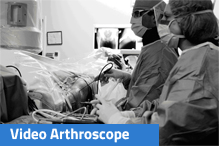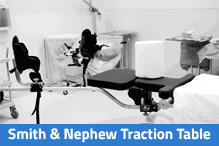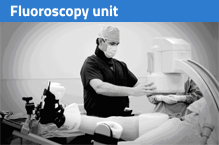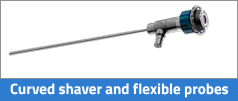Hip Arthroscopy

Introduction
Hip arthroscopy uses minimally invasive techniques to address a variety of hip problems in the young, active individual. Special instruments and cameras (Image 1) are passed through small incisions in the skin about the hip. Techniques have been developed using these particular instruments to correct injuries previously treated with large open incisions and surgical hip dislocation.
Anesthesia
Hip arthroscopy can be performed in an outpatient surgery center. Typically, a combination of techniques is used for anesthesia during the procedure, as well as for post-operative pain control. Dr. King employs a femoral nerve block in addition to general anesthesia during hip arthroscopic procedures. The use of a nerve block provides predictable post-operative pain control, while decreasing the amount of general anesthesia needed during the operative case.
Hip Traction and Special Equipment

Special tables are essential for patient positioning during hip arthroscopy. These tables provide traction of the hip joint to create space between the head of the femur and the hip socket (acetabulum). New traction systems were developed to attach to a variety of operative tables (Image 2). These systems help hold the legs and distract the hip during arthroscopy and labral repair. In addition, the leg is easily manipulated after the repair and bony resection (osteoplasty) to ensure the repair is stable and the bony impingement lesions have been removed.

A special X-ray unit, called fluoroscopy (Image 3), is utilized during traction to show that appropriate space has been created to allow safe surgical intervention with arthroscopy.
Incisions
The incisions used in hip arthroscopy are called portals. They are small 1 cm incisions and allow the passage of specialized instruments during the arthroscopic procedure. Typically Dr. King uses 2 portals, but additional placements may be necessary.
Specialty Instruments
The development of curved and flexible instruments has dramatically increased surgeons ability to address a variety of hip injuries with advanced operative techniques.

Dr. King performs hip arthroscopic procedures at the Des Peres Square Surgery Center in St. Louis, Missouri

